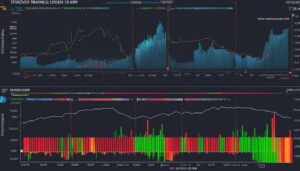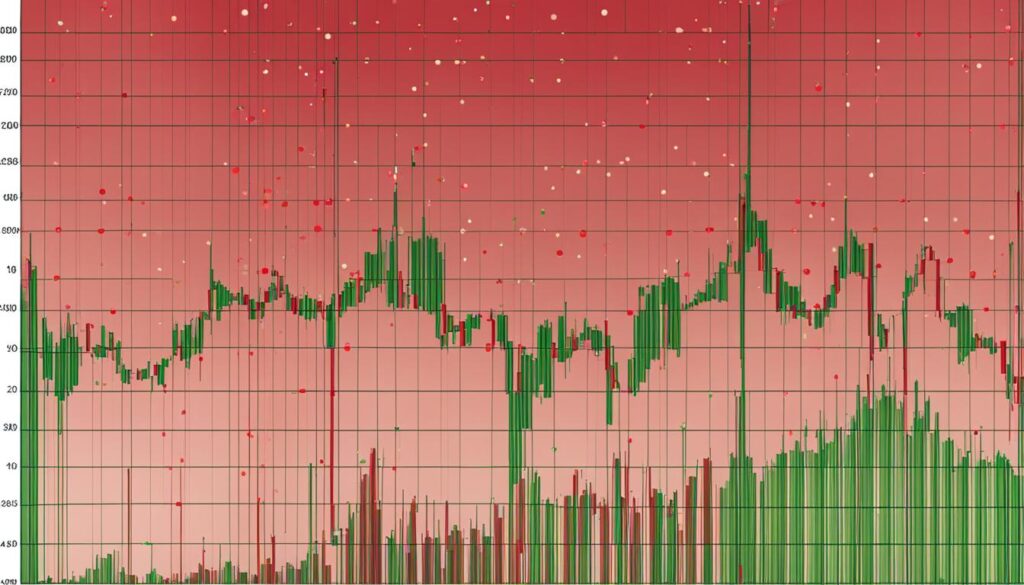Index rebalancing is a fundamental process that has a significant impact on market dynamics and investment strategies. As an investor, it is crucial to comprehend how index rebalancing affects the performance of securities within an index and the broader market as a whole. By understanding this concept, you can make informed decisions and navigate market changes effectively.
Key Takeaways:
- Index rebalancing involves adjusting the weights of securities within an index to maintain accuracy and relevance.
- Factors such as market capitalization, liquidity, and sector representation influence index rebalancing decisions.
- Effects of index rebalancing include increased price volatility, trading volume, and potential shifts in investor sentiment.
- Investment strategies can be impacted by index rebalancing, requiring portfolio reallocation to match the new index composition.
- Index rebalancing offers benefits such as maintaining index integrity and promoting diversification, but it also carries risks, including higher transaction costs and misalignment with individual investment strategies.
What is Index Rebalancing?
Index rebalancing is a fundamental process in the world of finance that involves recalibrating the components and weights of an index. It is a vital mechanism that ensures the index accurately reflects the target market or sector it represents. By reviewing the performance of the securities within the index, the weights of these securities are adjusted accordingly. This adjustment is necessary to maintain the index’s alignment with the ever-changing dynamics of the market it tracks.
Index rebalancing occurs regularly, typically on a quarterly or annual basis, depending on the specific index. The frequency of rebalancing aims to keep the index relevant and reflective of current market conditions and trends. Through this iterative process, the index remains a valuable benchmark for investors, providing insight into the broader market landscape.
For a better understanding of the index rebalancing process, consider the analogy of a scale. If the target market or sector undergoes significant changes, such as the rise or fall of certain securities, it can create an imbalance. Index rebalancing acts as the corrective mechanism, readjusting the weights of the securities to restore equilibrium and ensure an accurate representation of the market or sector.
The benefits of index rebalancing are multifaceted. Firstly, it allows investors to track and analyze market trends and performance accurately. Secondly, it helps maintain the integrity of the index as a benchmark, providing a reliable measure of market performance. Lastly, index rebalancing promotes transparency by ensuring that the index accurately reflects the target market or sector’s composition.
Index rebalancing is a meticulous process that helps investors navigate the ever-changing landscape of the financial markets. Through the recalibration and realignment of index components, this process ensures that the index remains a reliable indicator of market dynamics and trends.
Factors Influencing Index Rebalancing
Index rebalancing decisions are influenced by several factors that ensure the accuracy and representation of the index. These factors play a crucial role in maintaining the integrity of the index and aligning it with the target market or industry sector.
One of the primary factors considered in index rebalancing is market capitalization. Market capitalization refers to the total value of a company’s outstanding shares. Companies with higher market capitalization have a greater impact on the index. As a result, their weighting within the index may be adjusted to reflect their market significance.
Liquidity is another key consideration in index rebalancing. Securities with higher trading volumes are generally more liquid and easier to buy and sell. Index providers take into account the liquidity of the securities to ensure the index’s stability and efficiency.
Sector representation is also crucial in index rebalancing. The goal is to maintain an accurate reflection of the targeted market or industry sector within the index. This ensures that the index remains a reliable benchmark for investors and provides an accurate representation of the performance of that specific sector.
In summary, the factors influencing index rebalancing decisions encompass market capitalization, liquidity, and sector representation. These considerations ensure that the weights and components of the index accurately reflect the composition and dynamics of the underlying market.
Effects of Index Rebalancing on Market Dynamics
Index rebalancing has a significant impact on market dynamics, resulting in various effects that can influence price volatility and trading volume. During the rebalancing process, there is typically a substantial buying and selling of securities, leading to increased activity in the market. This heightened activity has the potential to cause short-term fluctuations in stock prices and trading volume.
Furthermore, the process of index rebalancing can attract heightened attention from market participants. The rebalancing announcement and subsequent adjustments to index components often garner significant interest from investors and traders. This increased attention can impact investor sentiment and overall market sentiment, as market participants analyze and react to the changes in the index composition.
Overall, the effects of index rebalancing on market dynamics can create a more dynamic and volatile trading environment in the short term. However, it is important to note that these effects may vary depending on the size and significance of the specific index undergoing rebalancing.
Increased price volatility and trading volume are common effects of index rebalancing, driven by significant buying and selling of securities. Additionally, the rebalancing process attracts increased attention from market participants, which can influence investor and market sentiment.
To better understand the effects of index rebalancing on market dynamics, let’s take a closer look at an example:
Example: S&P 500 Index Rebalancing
One of the most widely known examples of index rebalancing is the quarterly rebalancing of the S&P 500 Index. The S&P 500 is a benchmark index composed of 500 large-cap U.S. stocks, representing a significant portion of the overall U.S. market. Every quarter, the index undergoes a rebalancing process to ensure that it accurately reflects the market’s performance.
During the rebalancing period, the index provider reviews the performance and market capitalization of the constituent stocks. Based on this analysis, adjustments are made to the weights of the individual stocks within the index to maintain its representativeness. These adjustments can result in significant changes in the composition and weighting of the index.
As the rebalancing changes are announced, market participants react by adjusting their portfolios and trading the affected stocks. This increased trading activity can lead to short-term price volatility and higher trading volume as investors and traders take advantage of the opportunities created by the index changes.
It is important for investors to stay informed about index rebalancing events, as they can have an impact on their investment strategies and decision-making process.
| Effects of Index Rebalancing on Market Dynamics | |
|---|---|
| Increased price volatility | The rebalancing process often involves significant buying and selling of securities, resulting in short-term price fluctuations. |
| Higher trading volume | The increased trading activity during index rebalancing can result in higher overall trading volume in the market. |
| Heightened investor attention | Index rebalancing announcements attract increased attention from market participants, influencing investor sentiment. |
Next, we will explore the impact of index rebalancing on investment strategies, highlighting how it can influence portfolio reallocation and investment decision-making.
Impact of Index Rebalancing on Investment Strategies
Index rebalancing can have a significant impact on investment strategies, particularly for passive investors or those who closely track an index. When an index undergoes rebalancing, its composition changes, which requires investors to reallocate their portfolios to match the new weights and components of the index. This process is known as portfolio reallocation.
Portfolio reallocation involves buying or selling securities to maintain alignment with the index. If certain securities’ weights increase in the index, investors may need to buy more of those securities to match the new index weights. Conversely, if certain securities’ weights decrease, investors may need to sell them to reduce their exposure. This reallocation ensures that the portfolio remains in line with the index’s weighting scheme.
For active investors, index rebalancing can present opportunities to adjust their portfolios based on the anticipated market impact. By analyzing the changes in the index’s composition, active investors can identify potential investment opportunities that align with their investment strategies. They may choose to buy or sell securities accordingly to capitalize on the rebalancing events.
Here’s an example of how index rebalancing can impact investment strategies:
| Investment strategy | Impact of index rebalancing |
|---|---|
| Passive strategy | Requires portfolio reallocation to match the new index weights |
| Active strategy | Allows for proactive adjustments based on anticipated market impact |
As shown in the table above, both passive and active investment strategies are affected by index rebalancing. Passive strategies require portfolio reallocation to maintain alignment with the index, while active strategies can take advantage of rebalancing events to make strategic investment decisions.
Potential Benefits and Risks of Index Rebalancing
Index rebalancing offers potential benefits to investors. It helps maintain the integrity of the index, ensuring that it accurately reflects the target market or sector. Rebalancing can also promote diversification, as it adjusts the weights of securities based on their market performance. This can help prevent excessive concentration in a few stocks.
By rebalancing the index, investors can gain the following benefits:
- Accurate representation: Index rebalancing ensures that the index mirrors the current state of the market, providing investors with an accurate representation of the target market or sector.
- Diversification: Through index rebalancing, the weights of securities are adjusted based on their market performance. This promotes diversification by preventing overexposure to a few stocks, reducing the risk of concentration.
However, index rebalancing also carries certain risks, which investors should be aware of:
- Increased transaction costs: The rebalancing process involves increased trading activity, which can lead to higher transaction costs for investors.
- Mismatch with investment strategies: Changes in the index composition during rebalancing may not align with an investor’s preferred investment strategy or outlook, potentially impacting their portfolio’s performance.
Having a clear understanding of the benefits and risks associated with index rebalancing can help investors make informed decisions and effectively manage their portfolios.
Conclusion
In conclusion, index rebalancing is a critical process that ensures the accuracy and relevancy of market indices. The impact of index rebalancing on market dynamics cannot be ignored, as it can lead to increased price volatility and trading volume. As investors, it is essential to understand the effects of index rebalancing on investment strategies.
Index rebalancing requires portfolio adjustments to align with the new index weights and components. This allows investors to effectively navigate market changes and make informed investment decisions. By staying informed about the impact of index rebalancing, investors can adapt their strategies accordingly and take advantage of potential opportunities.
Overall, index rebalancing is a significant consideration for investors. It plays a crucial role in reflecting the current market landscape and can have far-reaching implications for investment performance. By understanding the implications of index rebalancing and staying proactive in portfolio management, investors can position themselves to capitalize on market dynamics and optimize their investment strategies.
FAQ
What is index rebalancing?
Index rebalancing refers to the process of recalibrating the components and weights of an index to maintain its representation and alignment with the target market or sector it represents.
What factors influence index rebalancing decisions?
Several factors influence index rebalancing decisions, including market capitalization, liquidity, and sector representation. Market capitalization refers to the total value of a company’s outstanding shares, with larger companies having a larger impact on the index. Liquidity refers to the ease of buying and selling securities, with higher trading volumes being favored. Sector representation aims to reflect the composition of the targeted market or industry sector.
What are the effects of index rebalancing on market dynamics?
Index rebalancing can have various effects on market dynamics, such as increased price volatility and trading volume. The rebalancing process often involves significant buying and selling of securities, which can impact stock prices and lead to short-term fluctuations. It can also attract increased attention from market participants, potentially influencing investor sentiment and market sentiment.
How does index rebalancing impact investment strategies?
Index rebalancing can impact investment strategies, particularly for passive investors or those who closely track an index. When an index undergoes rebalancing, the composition of the index changes, requiring investors to reallocate their portfolios to match the new weights and components. This can result in forced buying or selling of securities to maintain alignment with the index. Active investors may also take advantage of index rebalancing to identify potential investment opportunities or adjust their portfolios based on the anticipated market impact.
What are the potential benefits and risks of index rebalancing?
Index rebalancing offers potential benefits such as maintaining the integrity of the index and promoting diversification by adjusting the weights of securities based on their market performance. This prevents excessive concentration in a few stocks. However, it also carries risks, including increased transaction costs for investors due to the higher trading activity during the rebalancing process. Changes in index composition may also not align with an investor’s preferred investment strategy or outlook.
Source Links
Disclaimer
All information on this website is of a general nature. The information is not adapted to conditions that are specific to your person or entity. The information provided can not be considered as personal, professional or legal advice or investment advice to the user.
This website and all information is intended for educational purposes only and does not give financial advice. Signal Mastermind Signals is not a service to provide legal and financial advice; any information provided here is only the personal opinion of the author (not advice or financial advice in any sense, and in the sense of any act, ordinance or law of any country) and must not be used for financial activities. Signal Mastermind Signals does not offer, operate or provide financial, brokerage, commercial or investment services and is not a financial advisor. Rather, Signal Mastermind Signals is an educational site and a platform for exchanging Forex information. Whenever information is disclosed, whether express or implied, about profit or revenue, it is not a guarantee. No method or trading system ensures that it will generate a profit, so always remember that trade can lead to a loss. Trading responsibility, whether resulting in profits or losses, is yours and you must agree not to hold Signal Mastermind Signals or other information providers that are responsible in any way whatsoever. The use of the system means that the user accepts Disclaimer and Terms of Use.
Signal Mastermind Signals is not represented as a registered investment consultant or brokerage dealer nor offers to buy or sell any of the financial instruments mentioned in the service offered.
While Signal Mastermind Signals believes that the content provided is accurate, there are no explicit or implied warranties of accuracy. The information provided is believed to be reliable; Signal Mastermind Signals does not guarantee the accuracy or completeness of the information provided. Third parties refer to Signal Mastermind Signals to provide technology and information if a third party fails, and then there is a risk that the information may be delayed or not delivered at all.
All information and comments contained on this website, including but not limited to, opinions, analyzes, news, prices, research, and general, do not constitute investment advice or an invitation to buy or sell any type of instrument. Signal Mastermind Signals assumes no responsibility for any loss or damage that may result, directly or indirectly, from the use or dependence on such information.
All information contained on this web site is a personal opinion or belief of the author. None of these data is a recommendation or financial advice in any sense, also within the meaning of any commercial act or law. Writers, publishers and affiliates of Signal Mastermind Signals are not responsible for your trading in any way.
The information and opinions contained in the site are provided for information only and for educational reasons, should never be considered as direct or indirect advice to open a trading account and / or invest money in Forex trading with any Forex company . Signal Mastermind Signals assumes no responsibility for any decisions taken by the user to create a merchant account with any of the brokers listed on this website. Anyone who decides to set up a trading account or use the services, free of charge or paid, to any of the Broker companies mentioned on this website, bears full responsibility for their actions.
Any institution that offers a service and is listed on this website, including forex brokers, financial companies and other institutions, is present only for informational purposes. All ratings, ratings, banners, reviews, or other information found for any of the above-mentioned institutions are provided in a strictly objective manner and according to the best possible reflection of the materials on the official website of the company.
Forex/CFD trading is potentially high risk and may not be suitable for all investors. The high level of leverage can work both for and against traders. Before each Forex/CFD investment, you should carefully consider your goals, past experience and risk level. The opinions and data contained on this site should not be considered as suggestions or advice for the sale or purchase of currency or other instruments. Past results do not show or guarantee future results.
Neither Signal Mastermind Signals nor its affiliates ensure the accuracy of the content provided on this Site. You explicitly agree that viewing, visiting or using this website is at your own risk.



